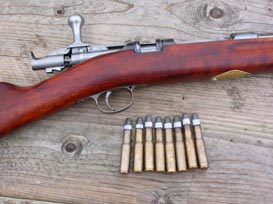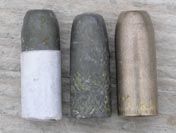Forum
Market
- Norsk brukt Husqvarna RB selges
- Winchester 1886 i kal 45-70
- Pedersoli Le Page
- Mainspring Vice Ønskes kjøpt
- Dier 50 Express/50-110
- rcbs 45 basic hylser cal til 348 win
- Fjær til fremre løpsbånd
On this day
9 October 1847
Slaget ved Huamantla ble utkjempet mellom en 2000 mann sterk mexicansk styrke under Santa Anna og 2700 amerikanske soldater under Joseph Lane under den mexicansk-amerikanske krig. Amerikanerne vant slaget, og blant de 13 døde var kaptein Samuel H.... Read more ...
Samuel H. Walker falt ved Huamantla
Slaget ved Huamantla ble utkjempet mellom en 2000 mann sterk mexicansk styrke under Santa Anna og 2700 amerikanske soldater under Joseph Lane under den mexicansk-amerikanske krig. Amerikanerne vant slaget, og blant de 13 døde var kaptein Samuel H. Walker – kjent som bidragsyter til Colts Walker Colt-revolver.
Walker og fire kompanier kavaleri angrep Santa Annas lansenérer og drev mexicanerne tilbake. Da Santa Anna ledet gikk til motangrep like etter ble Walker skutt av en sivilist inni et hus. Noen mener han ble truffet av et hagleskudd som ble avfyrt fra en balkong. Resten av hans menn tok tilflukt i en kirke og mexicanerne trakk seg tilbake til Querétaro.

Chat
Offline
No chatting right now.
(You must be logged in to the forum to chat.)
Featured article

June, 1863: As the American Civil War raged on, a newly made percussion revolver passed the gates of the E. Remington & Sons factory in the small city of Ilion, New York. Exactly 150 years after the old veteran became mine. Now it was time to bring it back to life.
Portrait of an original Remington percussion revolver
The Jarmann rifle - Part 2 - Shooting
 About
AboutPublished: 12 September 2008 by Øyvind Flatnes.
Edited: 12 September 2008.
Views: 29895
 Les artikkel på norsk
Les artikkel på norsk
The 10.15 x 61 cartridge for which the Jarmann rifle was chambered for was also used in numerous civilian firearms, for example, rifles made by Lars Hansen Hagen and Hans Larsen. It was decided as early as 1877 that the calibre should be 10.15 mm, when the joint Norwegian-Swedish gun committee found that this would be the most appropriate military calibre for the future.
Find out more!
You can read more about the use of the Jarmann rifle, as well as other early military repeating black powder rifles in the brand new book From Musket to Metallic Cartridge: A Practical History of Black Powder Firearms.
Loading 10.15 x 61 cartridges is no hocus-pocus. Brass, bullets and die sets are not common, but not impossible to obtain either. A die set is not necessary if you use a single shot rifle (see the chapter on loading black powder cartridges in the black powder book. In that chapter you also learn how to paper patch bullets).
The loading components
Brass can either be fireformed from .348 Winchester cases or you can buy 10.15 x 61 Jarmann brass from Bertram Brass. .348 Winchester is also often used to form brass for the 12 mm Remington as well, which was the Jarmann rifle's predecessor. Fireformed .348 Winchester brass is a tad shorter compared to original brass, but they do the job as good as anything. The '61' in '10.15 x 61' is the cartridge length in mm by the way. There are also bullet moulds available. Jämttången manufactures Jarmann bullet moulds, and as a joint effort some shooters from this web page have ordered a bullet custom bullet moulds from Lee for the Jarmann. Contact me for more information about this mould. See the bottom of this article for other moulds you can use.
Loading for the 10.15 x 61 Jarmann

10.15 x 61 Jarmann die set
from CH4D.
As you could see in part 1 the original powder charge varied from 68 to 78 grains of black powder. This may be a good starting point. The Jarmann rifle never used grease grooved bullets, but relied on a paper patched lead slug that weighed 337 grains. If you use a paper patched bullet it is important to use some sort of lubrication behind the bullet, for example, a grease cookie. In part 1 you can read the measures that were taken in 1889 to improve the accuracy with the help of extra lubrication.
The first bullets I tried in my Jarmann were swaged bullets from the Norwegian company Parabellum, now called hjemmelading.no. These were sold both lubed and unlubed, and the diameter was 10.30 mm. The lubed bullets had no traditional grease grooves but were knurled to better hold the lube. I used brass from Bertram, and the brass had to be fireformed. I loaded eight cartridges with 70 grains of Wano PP with a bee's wax wad over the powder, a wad of SPG lube on top of that again, then a new bee's wax disc which was placed under one of the greased swaged bullets. At this time I hadn't received my die set, so it was a bit difficult to seat the bullets because of the tight case neck.


Paper patched swaged bullet from Parabellum,
the same bullet lubed with SPG bullet lube
and an original steel jacketed bullet to the
right. On the picture to the left you can see
a black powder cartridge with a paper patched
bullet next to an original smokeless cartridge.
The next thing I tried was the same load and bullet, but the bullet was sized to .401" (10.19 mm) with a Lee lube and size kit. The bullets were paper patched to 10.34 mm, and they were still too large to fit in the case. When this article was written I still waited for my die set which would have been useful in a situation like this because I could have used it to flare the case mouth. Instead I tried an experiment that I didn't believe much in before I started it: I ran the paper patched bullets through the .401" sizer. The sizing went well, but the accuracy was poor (see the picture of the target). I did not recover any of the paper patches, probably because it stuck to the bullet because of the heavy sizing. At best, the accuracy was miserable.


The first shots from my Jarmann rifle. On the picture to the right you see a comparison between the first group and a target shot with heavily resized paper patched bullets. In other words, the latter experiment was no great success.
Update
 After this article was written I have tested the rifle some more. The target to the right is shot at 50 metres. Four shots are in the same hole, while a flier down to the right ruins a potentially very good five shot group. Load: 70 grains of Wano PP black powder, paper patched swaged 337 grain bullet sized to .401" before patching, Federal Magnum #215 Large Rifle primer. The wad column consisted of a bee's wax wad on top of the powder, a grease cookie and a milk carton wad.
After this article was written I have tested the rifle some more. The target to the right is shot at 50 metres. Four shots are in the same hole, while a flier down to the right ruins a potentially very good five shot group. Load: 70 grains of Wano PP black powder, paper patched swaged 337 grain bullet sized to .401" before patching, Federal Magnum #215 Large Rifle primer. The wad column consisted of a bee's wax wad on top of the powder, a grease cookie and a milk carton wad.
I have also found several other bullets that may work in a Jarmann. The bullets below are examples of bullets I have tested in 10.15 x 61 Jarmann:

From the left: Lyman 403169, N.E.I. 350 411, N.E.I. 350 411 sized down to .401" (10,19 mm), Clarry Haglund Marmann bullet and paper patched and naked swaged 337 grains bullet from Parabellum.
